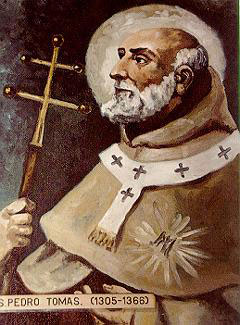
Feastday: January 25
Birth: 1305
Death: 1366
Carmelite Latinpatriarch and papal legate. Peter was born in Gascony, France and joined the Carmelites while still a young man. In 1342 he was appointed procurator of the order and, from Avignon, he oversaw the organization and government of the Carmelites. As Avignon was then the seat of the popes, he entered into their service, attracting papal attention because of his skills as a preacher and his eloquence. Named to the papal diplomatic service, he held the post of papal legate to Genoa, Milan, and Venice, and was appointed bishop of Patti and Lipari in 1354, bishop of Coron in 1359, archbishop of Candia in 1363, and titular Patriarch of Constantinople in 1364. At the behest of Pope Urban V, he journeyed to Serbia, Hungary, and Constantinople in an effort to organize a crusade against the Turks. He took part in a military operation against Alexandria, Egypt, in 1365 during which he was severely wounded. He died from his injuries at Cyprus a few months later. While never formally canonized, his feast was permitted to the Carmelites in 1608.
| This article needs additional citations for verification. (August 2018) |
This article may be expanded with text translated from the corresponding article in French. (February 2017) Click [show] for important translation instructions.
|
Peter Thomas (1305-1366) (also known as Petrus de Thomas) was a Carmelite friar and is recognized as a saint by the Roman Catholic Church.
Life
Peter Thomas was born around the year 1305 to a very poor family in Périgord. His father was a serf. When still a teenager, he left his parents and his younger sister to ease the burdens on his family. He went to the nearby small town of Monpazier, where he attended school for about three years, living on alms and teaching younger pupils. He led the same type of life at Agen until the age of twenty, when he returned to Monpazier.
Carmelite friar
The prior of the Carmelite convent of Lectoure employed Thomas as a teacher for a year in that school. He entered the Carmelite Order at the age of twenty-one and made his profession of religious vows at Bergerac where he taught for two years. He studied philosophy at Agen, where he was ordained a priest three years later. For the next few years, he continued his studies, while also teaching in Bordeaux, Albi, and again in Agen. This was followed by three years of study in Paris. He was preaching in Cahors, during a procession held to in hopes of an end to a serious drought, when rain began to fall. This was viewed by many as miraculous.
He was the Order's Procurator General and an official preacher at the Papal Court of Pope Clement VI at Avignon. In 1354 he was made bishop of Patti and Lipari. In 1363 he was appointed Archbishop of Crete, and in 1364 he became the Latin Patriarch of Constantinople. He died in 1366 at Famagusta in Cyprus.
Saint Peter Thomas is depicted in an altarpiece painted by Francisco de Zurbaran for the College of San Alberto, Seville, which is currently held by the Museum of Fine Arts, Boston.
Sources
There are two biographies written about Peter Thomas: one by Philippe de Mézières (d. 1405), chancellor of King Peter I of Cyprus and the other by the Franciscan John Carmesson, minister of the province of the Holy Land, who had delivered the funeral eulogy.





